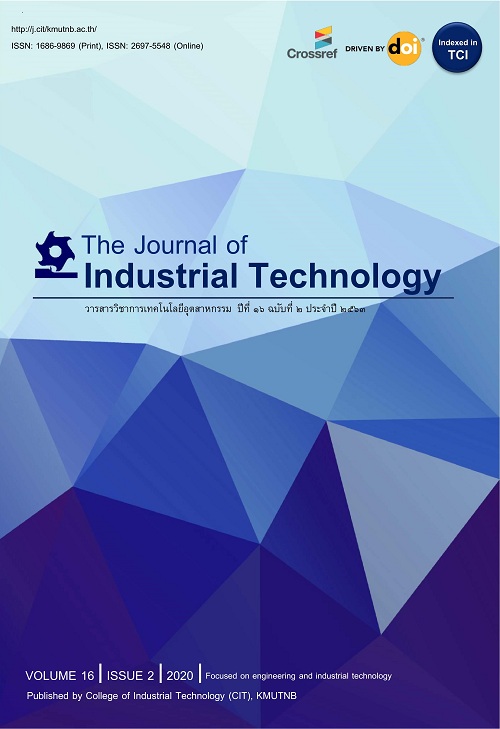Fixed-bed Adsorption of Acid Dye using Granular Activated Alumina Prepared from Aluminum Scrap
การดูดซับสีย้อมแอซิดในคอลัมน์เบดนิ่งด้วยเม็ดอลูมินากัมมันต์ที่เตรียมจากเศษอลูมิเนียม
Abstract
งานวิจัยนี้มีวัตถุประสงค์เพื่อศึกษาประสิทธิภาพการดูดซับสีย้อมเหลืองแอซิด 36 ในสารละลายด้วยเม็ดอลูมินากัมมันต์ที่เตรียมจากเศษอลูมิเนียมในคอลัมน์เบดนิ่ง โดยศึกษาปัจจัยความสูงของเบด 2-4 cm อัตราการไหลของสารละลายสีย้อม 10-20 mL/min และความเข้มข้นเริ่มต้น 40-60 mg/L ที่มีผลต่อลักษณะการเบรคทรูของการดูดซับในคอลัมน์เบดนิ่ง พบว่าการดูดซับสีย้อมเหลืองแอซิด 36 ที่มีความเข้มข้นของสารละลาย 50 mg/L ในคอลัมน์เบดนิ่งที่มีความสูงของเบดอลูมินากัมมันต์ 4 cm อัตราการไหล 15 mL/min สามารถดูดซับสีย้อมเหลืองแอซิด 36 ได้สูงสุด 157.35 mg/g แสดงให้เห็นว่าเม็ดอลูมินากัมมันต์เป็นสารดูดซับที่มีประสิทธิภาพต่อการกำจัดสีย้อมเหลืองแอซิด 36 ในคอลัมน์เบดนิ่ง ทั้งนี้อัตราการไหลมีผลต่อประสิทธิภาพการดูดซับและเวลาอิ่มตัวของสารดูดซับซึ่งขึ้นกับความสูงของเบดและความเข้มข้นของสีย้อม เมื่อวิเคราะห์ข้อมูลการทดลองโดยศึกษากราฟเบรคทรูเทียบกับแบบจำลองจลนศาสตร์ของ Thomas, Yoon-Nelson และ Adams-Bohart พบว่าพฤติกรรมของกราฟเบรคทรูมีความสอดคล้องกับแบบจำลองของ Thomas และ Yoon-Nelson โดยมีค่าสัมประสิทธิ์สหสัมพันธ์ R2 ³ 0.89 ที่สภาวะต่างๆ และสามารถทำนายความสามารถในการดูดซับเพื่อนำไปใช้ในการออกแบบกระบวนการบำบัดน้ำเสียจากสีย้อม
This research aimed to study the adsorption performance of acid yellow 36 (AY36) from an aqueous solution using granular activated alumina (GAA) prepared from aluminum scrap in a fixed-bed column. The effects of GAA bed height (2-4 cm), dye solution flow rate (10-20 mL/min), and initial dye concentration (40-60 mg/L) on the breakthrough characteristics of the fixed-bed adsorption were investigated. The maximum adsorption capacity of the column was found to be 157.35 mg of AY36 per gram of GAA adsorbent at a bed height of 4 cm, initial dye concentration of 50 mg/L, and flow rate of 15 mL/min. The results revealed that GAA can be used as an effective adsorbent for the removal of acid yellow 36 in the fixed-bed column. The flow rate affected the adsorption efficiency and adsorbent saturation time, which depended on bed height and dye concentration. Thomas, Yoon-Nelson, and Adams-Bohart kinetic models were applied to analyze the experimental data and calculate the characteristic parameters of the column dynamics. The behaviors of the breakthrough curves fitted well to the Thomas and Yoon-Nelson models with coefficients of correlation R2 ³ 0.89 at different conditions. These models can predict the adsorption capacity in a fixed-bed column to be used in the design of dye wastewater treatment processes.
Keywords
[1] N. Sekar, 15 - Acid dyes, Handbook of textile and industrial dyeing, Woodhead Publishing, PA, USA, 2011, pp. 486-514.
[2] S. Charola, R. Yadav, P. Das and S. Maiti, Fixed-bed adsorption of Reactive Orange 84 dye onto activated carbon prepared from empty cotton flower agro-waste, Sustainable Environment Research, 2018, 28(6), 298-308.
[3] S. Banerjee, S. Dubey, R.K. Gautam, M.C. Chattopadhyaya and Y.C. Sharma, Adsorption characteristics of alumina nanoparticles for the removal of hazardous dye, Orange G from aqueous solutions, Arabian Journal of Chemistry, 2019, 12(8), 5339-5354.
[4] W.T. Mohammed, H.F. Farhood and A.H.B. Al-Mas’udi, Removal of Dyes from Wastewater of Textile Industries Using Activated Carbon and Activated Alumina, Iraqi Journal of Chemical and Petroleum Engineering, 2009, 10(1), 43-52.
[5] A.A. Ahmad and B.H. Hameed, Fixed-bed adsorption of reactive azo dye onto granular activated carbon prepared from waste, Journal of Hazardous Materials, 2010, 175(1–3), 298-303.
[6] M. Nainamalai, M. Palani, B. Soundarajan and A. Ebinesar J.S.S, Decolorization of synthetic dye wastewater using packed bed electro-adsorption column, Chemical Engineering and Processing - Process Intensification, 2018, 130, 160-168.
[7] J. López-Cervantes, D.I. Sánchez-Machado, R.G. Sánchez-Duarte and M.A. Correa-Murrieta, Study of a fixed-bed column in the adsorption of an azo dye from an aqueous medium using a chitosan–glutaraldehyde biosorbent, Adsorption Science and Technology, 2017, 36(1–2), 215-232.
[8] C.A. Demarchi, M. Campos and C.A. Rodrigues, Adsorption of textile dye Reactive Red 120 by the chitosan–Fe(III)-crosslinked: Batch and fixed-bed studies, Journal of Environmental Chemical Engineering, 2013, 1(4), 1350-1358.
[9] S. Rouf and M. Nagapadma, Modeling of fixed bed column studies for adsorption of azo dye on chitosan impregnated with a cationic surfactant, International Journal of Scientific and Engineering Research, 2015, 6(2), 538-544.
[10] R.G. Mavinkattimath, V.S. Kodialbail and G. Srinikethan, Continuous fixed-bed adsorption of reactive azo dye on activated red mud for wastewater treatment-Evaluation of column dynamics and design parameters, Environmental Science and Pollution Research, 2023, 30(19), 57058–57075.
[11] M. Dutta and J.K. Basu, Fixed-bed column study for the adsorptive removal of acid fuchsin using carbon–alumina composite pellet, International Journal of Environmental Science and Technology, 2013, 11(1), 87-96.
[12] P. Kamthita and S. Tiamsri, Application of response surface methodology for optimization of g-alumina nanoparticles synthesis and acid dye adsorption, Journal of Current Science and Technology, 2019, 9(1), 1-15.
[13] A.P. Lim and A.Z. Aris, Continuous fixed-bed column study and adsorption modeling: Removal of cadmium (II) and lead (II) ions in aqueous solution by dead calcareous skeletons, Biochemical Engineering Journal, 2014, 87, 50-61.
[14] H.I. Albroomi, M.A. Elsayed, A. Baraka, and M.A. Abdelmaged, Batch and fixed-bed adsorption of tartrazine azo-dye onto activated carbon prepared from apricot stones, Applied Water Science, 2016, 7(4), 2063-2074.
DOI: 10.14416/j.ind.tech.2023.12.007
Refbacks
- There are currently no refbacks.






